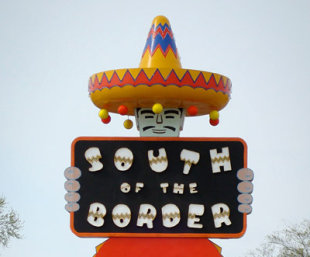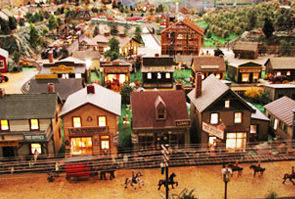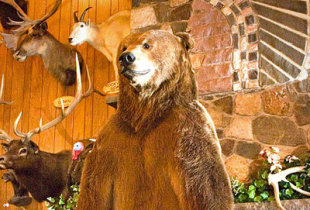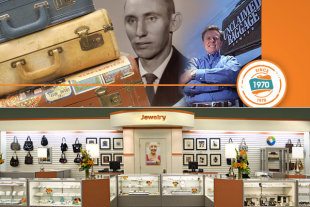MORE FROM CNBC.COM
More surprising still is that these products of the automobile’s golden age continue to thrive in a time of air travel and triple-digit gas prices. We asked the owners of some of the longest-enduring attractions what allows them to survive.
Read on for some great American roadside attractions:
Wall Drug
Wall, South Dakota
In the depths of the Depression, Ted Hustead’s grandmother drew up signs offering travelers free ice water in order to draw business to her husband’s struggling pharmacy in a tiny town near a nascent Mount Rushmore. Today, Wall’s billboards stretch as far as Minnesota and the store, restaurant and gift shop see as many as 15,000 visitors on a summer day. “We’re on our second- and third-generation customer,” says Hustead, grandson of the founders. “Grandparents want to share an experience that they had when they were a kid.”
That experience has evolved “to entertain, educate and do it with world-class aesthetics,” says Hustead. Famous for its ubiquitous bumper stickers, Wall displays a priceless collection of Western art. In addition to its Yosemite and Rushmore souvenir sales, the Husteads do a half-million dollar trade in cowboy boots alone.
South of the Border
Dillon, South Carolina
The border in question is with Robeson County, N.C., less than a mile up Interstate 95, where alcohol was banned when Al Schafer opened his beer stand in 1949. It attracted not only Schafer’s thirsty neighbors, but high-end “Cadillac customers” bound for Florida. When a souvenir salesman traded his samples for beer one day, “they sold as fast as my granddad put them out,” says Ryan Schafer, who owns the complex today with his father.
The Cadillac customers fly now, but thousands of motorists are lured by 175 billboards that begin in Virginia, to what has become a small town, with a motel, gift shop and restaurant. The first sign that they’ve made it? A vision of Pedro, a 100-foot statue of the mascot.
Roadside America Miniature Village
Shartlesville, Pennsylvania
Beginning in 1903, Laurence Gieringer built more than 300 miniature structures, which he displayed around his hometown of Reading before moving to Shartlesville in 1941. Packed with homes, businesses, and more than 10,000 handmade trees, Roadside America is actually eight villages set in different time periods.
Nostalgia is part of every attraction’s formula, but Roadside America relies on it almost exclusively. The display has not changed since Gieringer died in 1963. Says granddaughter Dolores Heinsohn, the current owner: “I have people thanking me for not changing. Those are the people who mean the most to me.”
The Thing
Dragoon, Arizona
Settling near Interstate 10 after years of touring as a carnival sideshow, the Prince family opened "The Thing!" Museum in 1951 and quickly leased the attraction to the Bowlins, who owned a string of Western-themed travel centers. What is The Thing? Even director of operations Kit Johnson replies, “Don’t know,” but we can reveal that after 50 billboards spanning more than 300 miles, the “Mystery of the Desert” is somewhat anti-climactic. But surrounded by eerie dioramas and Native American trinkets, The Thing still draws 50,000 visitors a year, testifying to the power of the billboard build-up.
Space Farms Zoo and Museum
Sussex, New Jersey
Parker Space calls his family’s 84-year-old zoo, farm museum and restaurant “a lifestyle, not a job.” That lifestyle includes farming 180 acres to supplement feed for the hoof stock, removing road kill from local byways (which is fed to the zoo’s big cats) and tending to a menagerie of more than 500 animals, including lions, tigers and seven species of bears.
Space has a dedicated employee handling regulatory paperwork, a costly reality for every small business that in Space’s industry at least, keeps other costs down. “If you could put a lion on eBay, he’d go for $100,000,” says Space. “But buyers are limited to places where it’s legal to keep him.”
Iowa 80
Walcott, Iowa
Advertised as the world’s largest truck stop, the sprawling waypoint on Interstate 80 was founded by Bill Moon, a location scout for the Standard Oil Corporation. Moon eventually bought his employer out and turned Iowa 80 into a big-rig spa, with a truck-washing machine of Moon’s invention and spotless 24-hour showers for drivers. “He would talk with truckers about their concerns,” says longtime employee Heather DeBaillie. “He wanted to know how to make their lives easier.”
Now run by Moon’s children, Iowa 80 draws 5,000 customers a day in summertime, half of them non-truckers stopping to eat in the food court or simply to fuel up, and check out Moon’s trucking museum. In winter, the traffic reverts to 80 percent professional drivers who know they can get everything from to-die-for pork chops to a gym workout to a bath for their dogs.
Longhorn Bar and Grill
Amado, Arizona
The 40-foot steer skull is the work of Michael Kautza, whose “commercial sculptures” dot the Tucson area. The skull turned an unassuming adobe building into an instant landmark, visible for miles on Interstate 19. Owners Edward Madril and Al Reynolds bought the place in 1993 after being left to wait by the seller in the parking lot. “In that half-hour,” says Madril, “five cars with out-of-state plates stopped to take pictures. We thought, ‘There’s something here.’”
If the skull gets them to the restaurant, Madril’s job is to make them stay and drop some dough. Madril cites his “Spaghetti Western” fare—an unconventional combination of Mexican, American and Italian cuisine—and the $2.50 margaritas.
Unclaimed Baggage Center
Scottsboro, Alabama
Two types make up visitors to the Unclaimed Baggage Center — daytrippers looking for bargains and the curious who come from all over to mull what other travelers have left behind. Since 1970, the Owens family has made a living buying luggage the airline cannot reconnect to passengers and selling the contents — house slippers to diamond jewelry to harpoons — at a discount.
The business has grown from a rented house stocked with card tables to a 40,000-square-foot facility whose yearly draw, at nearly a million customers, dwarfs other taller, weirder attractions. Besides the bargains and the gawking factor, the Owenses attribute their success to their almost spiritual mission. “We take these misfit toys and put them back into society in a purposeful manner,” says director of marketing Brenda Cantrell.
Wigwam Village Motel
Cave City, Kentucky
One of seven faux-teepee encampments that dotted the highways in the 1930s, Cave City’s Wigwam Village motel is the oldest surviving example of entrepreneur Frank Redford’s original concrete design. All of the villages feature a large central teepee housing the office and a restaurant with the 32-foot-tall guest-room teepees arrayed in a semi-circle around it, all decorated in a Southwest Native American theme.
Redford captured the imaginations of bored kids with his eye-catching kitsch in the pre-Interstate days, but he also invented an early form of franchising, allowing imitators to build similar Wigwam Villages along Route 66 west of Kentucky, in return for the proceeds of coin-operated radios installed in the rooms.
Pops
Arcadia, Oklahoma
Nostalgic for the road trips he used to take with his father, Aubrey K. McClendon, CEO of the natural-gas giant Chesapeake Energy Corp., planted Pops on some land he owns along Route 66 in 2007, naming it in honor of his dad and the fizzy beverages he remembers from those days. Conscious that “you have to have a clever gimmick to make it on Route 66,” McClendon hired architect Rand Elliott to design a 66-foot, LED-lit pop bottle that beckons drivers from the highway. Inside, Pops stocks more than 600 brands of soda pop from Moxie to modern flavors.
Incorporating the essentials of an iconic structure, nostalgia and big portions, Pops was an instant success, and now serves about 3,000 diners on a summer day. Says general manager Marty Doepke, “It’s a matter of finding your niche.”
Click here to see Outrageous American Roadside Attractions.
Source(http://travel.yahoo.com/ideas/outrageous-american-roadside-attractions.html?page=2)










No comments:
Post a Comment